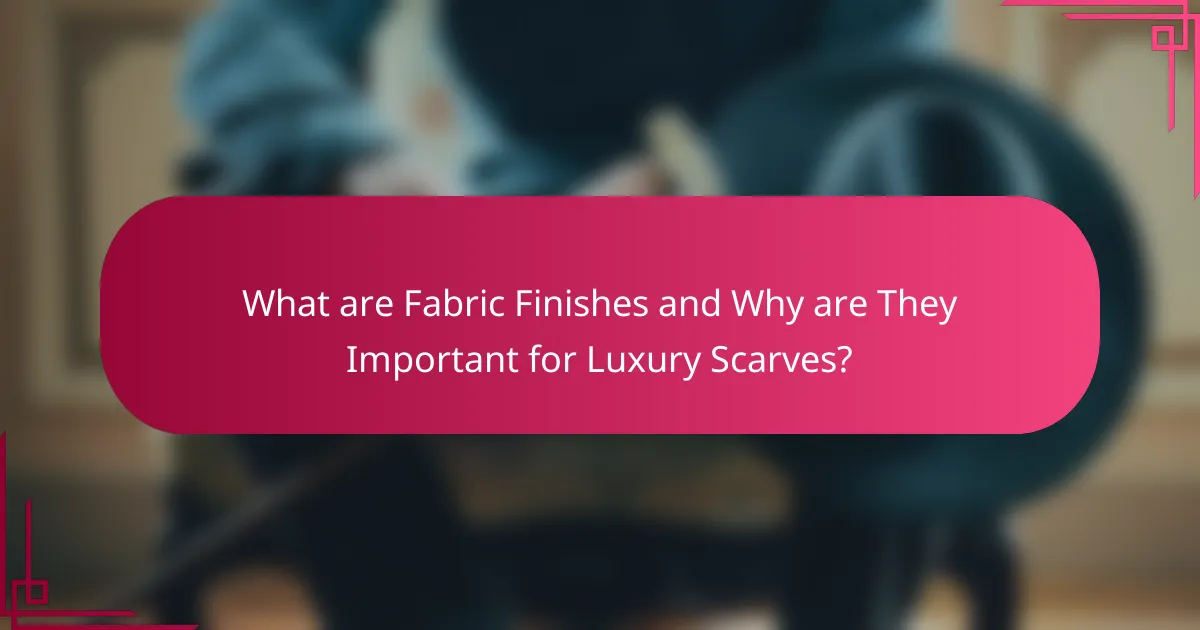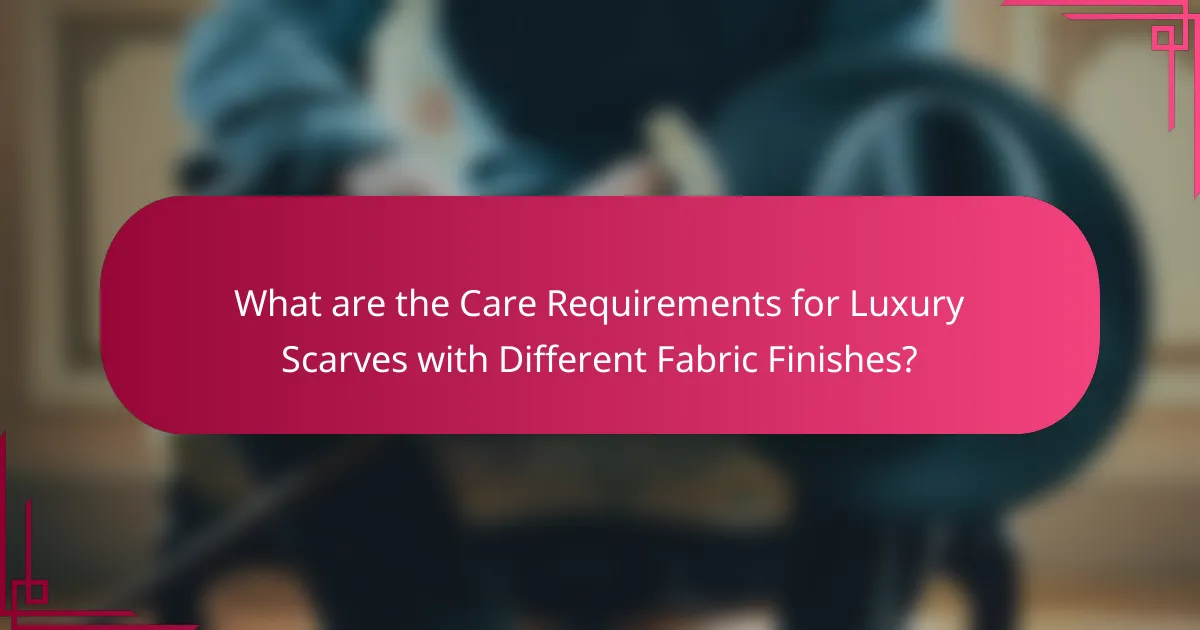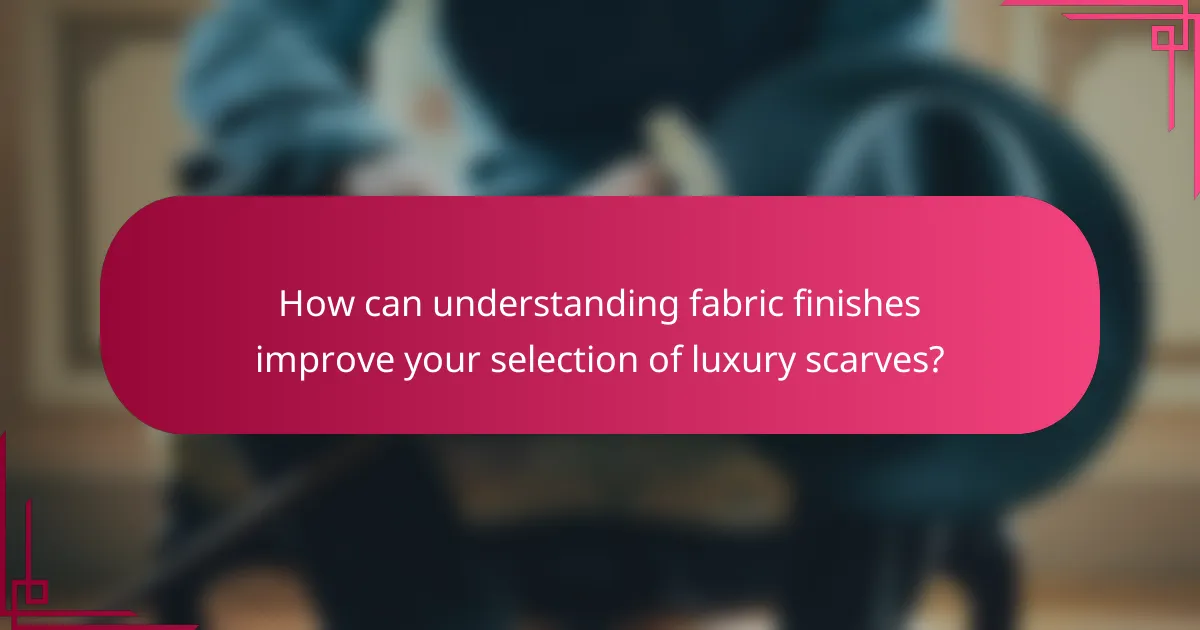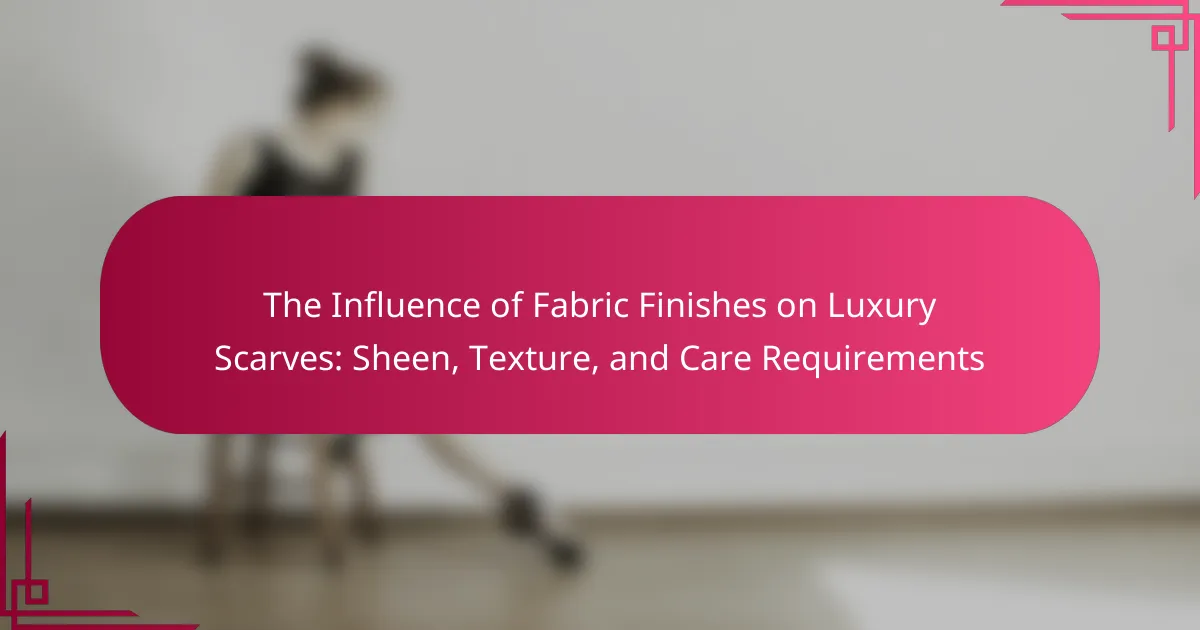Fabric finishes are treatments applied to textiles that enhance their appearance, texture, and performance, playing a critical role in the quality of luxury scarves. This article explores how various fabric finishes, including dyeing, coating, and softening, contribute to the aesthetic appeal and functionality of luxury scarves, impacting aspects such as sheen, drape, and durability. Additionally, it outlines the specific care requirements associated with different materials, such as silk, wool, cashmere, and linen, ensuring the longevity and maintenance of these high-end accessories. Understanding these factors allows consumers to make informed choices that align with their style preferences and practical needs.

What are Fabric Finishes and Why are They Important for Luxury Scarves?
Fabric finishes are treatments applied to textiles to enhance their appearance, texture, and performance. These finishes can include processes such as dyeing, coating, and softening. For luxury scarves, fabric finishes are crucial as they contribute to the overall quality and aesthetic appeal. They can provide a luxurious sheen, improve drape, and enhance durability. Additionally, finishes can affect care requirements, making fabrics easier to clean or more resistant to stains. High-quality fabric finishes often distinguish luxury scarves from standard products, ensuring they meet consumer expectations for elegance and functionality.
How do different fabric finishes affect the overall quality of luxury scarves?
Different fabric finishes significantly impact the overall quality of luxury scarves. Finishes like satin, matte, and textured can enhance or diminish the scarf’s aesthetic appeal. Satin finishes provide a glossy sheen, which often elevates the perceived luxury of the scarf. Matte finishes, on the other hand, offer a more understated elegance. Textured finishes can add depth and interest, making the scarf more visually engaging. The choice of finish also affects the fabric’s durability and care requirements. For example, satin may require more delicate handling compared to sturdy textured fabrics. These factors collectively influence how a luxury scarf is perceived in terms of quality and value.
What are the common types of fabric finishes used in luxury scarves?
Common types of fabric finishes used in luxury scarves include satin, silk, and cashmere. Satin finishes provide a glossy surface, enhancing visual appeal. Silk finishes offer a soft, smooth texture, which is highly desirable in luxury items. Cashmere finishes add warmth and softness, making scarves comfortable to wear. Other finishes may include brushed, which gives a fuzzy texture, and embossed, which creates patterns. Each finish contributes distinct characteristics to the scarf’s overall feel and appearance.
How does the choice of fabric finish influence the feel and appearance of a scarf?
The choice of fabric finish significantly influences the feel and appearance of a scarf. Different finishes, such as matte, satin, or brushed, alter the texture and sheen of the fabric. A satin finish provides a smooth, glossy surface that enhances visual appeal. In contrast, a matte finish offers a more subdued look and a softer touch. Brushed finishes create a fuzzy texture, resulting in a cozy feel. The finish also affects how light interacts with the scarf, impacting its overall aesthetic. For example, satin reflects light, making colors appear more vibrant. Conversely, matte finishes absorb light, giving a more muted appearance. Thus, the fabric finish is crucial in determining both tactile experience and visual presentation of a scarf.
What role does sheen play in the appeal of luxury scarves?
Sheen significantly enhances the appeal of luxury scarves. It adds a visual richness that attracts attention. High sheen often indicates a premium fabric quality, such as silk or satin. This reflective quality can elevate the overall aesthetic of the scarf. Consumers associate sheen with sophistication and elegance. Scarves with a pronounced sheen are often preferred for formal occasions. The interplay of light on a shiny surface creates an alluring effect. This contributes to the perceived value and desirability of the scarf.
What types of sheen are available for luxury scarf fabrics?
Luxury scarf fabrics are available in several types of sheen. Common types include satin, silk, and chiffon. Satin has a glossy finish that reflects light beautifully. Silk offers a natural sheen that varies with the weave. Chiffon has a subtle sheen, providing a delicate appearance. Other types may include organza and taffeta, both known for their crisp, reflective surfaces. Each type of sheen contributes to the overall elegance and appeal of luxury scarves.
How does sheen affect the perception of luxury in scarves?
Sheen significantly enhances the perception of luxury in scarves. A high sheen often indicates the use of premium materials like silk or satin. These fabrics reflect light, creating an elegant and sophisticated appearance. This visual appeal is associated with luxury and exclusivity. In contrast, scarves with a matte finish may be perceived as more casual or less refined. Research shows that consumers often equate sheen with quality and craftsmanship. For example, a study by the Fashion Institute of Technology found that sheen influences consumer preferences for luxury items. Thus, the presence of sheen in scarves plays a crucial role in shaping their luxury perception.
How does texture enhance the experience of wearing luxury scarves?
Texture enhances the experience of wearing luxury scarves by providing comfort and aesthetic appeal. The tactile sensation of different textures can evoke feelings of warmth and softness against the skin. Materials like cashmere or silk offer a luxurious feel, which enhances the overall wearing experience. Texture also contributes to the visual interest of the scarf, making it more appealing. A textured surface can reflect light differently, adding depth and dimension. This can elevate the style of an outfit, making it more sophisticated. Furthermore, the right texture can improve the drape and flow of the scarf, allowing for versatile styling options. Ultimately, the interplay of texture and fabric quality defines the luxury experience of wearing a scarf.
What are the different textures found in luxury scarf fabrics?
Luxury scarf fabrics exhibit a variety of textures. Common textures include smooth, soft, and plush. Silk scarves are known for their smooth texture, providing a luxurious feel. Cashmere offers a soft texture, ideal for warmth and comfort. Wool can present a slightly coarse texture, adding durability. Velvet scarves have a plush texture, creating a rich appearance. Chiffon is lightweight and has a sheer texture, adding elegance. Each texture contributes to the overall aesthetic and functionality of luxury scarves.
How does texture contribute to the functionality of a scarf?
Texture directly impacts the functionality of a scarf by influencing its warmth, drape, and grip. A soft texture enhances comfort, making the scarf pleasant to wear against the skin. Coarse textures can provide better insulation, retaining heat effectively. Textures like ribbed or knitted patterns can enhance grip, preventing slippage when worn. Additionally, the texture affects how the scarf drapes and styles, influencing versatility in fashion. For example, silk scarves with a smooth texture can be elegantly tied, while wool scarves with a thicker texture offer a more casual look. The choice of texture also determines care requirements, as delicate fabrics may need special washing methods. Overall, texture is a key attribute that enhances both the practicality and aesthetic appeal of a scarf.

What are the Care Requirements for Luxury Scarves with Different Fabric Finishes?
Luxury scarves require specific care based on their fabric finishes. Silk scarves should be dry cleaned to maintain their sheen and prevent damage. Wool scarves can be hand washed in cold water with a mild detergent, then laid flat to dry. Cashmere scarves require gentle hand washing or dry cleaning to preserve softness. Linen scarves benefit from machine washing on a gentle cycle, followed by air drying to avoid wrinkles. Each fabric finish has unique care requirements to extend the life and appearance of the scarf. Proper care helps maintain quality and prevents deterioration over time.
Why is proper care essential for maintaining luxury scarves?
Proper care is essential for maintaining luxury scarves to preserve their quality and appearance. Luxury scarves are often made from delicate materials like silk, cashmere, or fine wool. These fabrics can be easily damaged by improper washing, exposure to sunlight, or incorrect storage. For instance, silk can lose its sheen and become discolored if washed with harsh detergents. Cashmere requires gentle handling to avoid pilling and stretching. Regular cleaning and careful storage help maintain the scarf’s texture and prevent wear. According to a study by the Textile Research Journal, proper care extends the lifespan of luxury textiles significantly.
What are the general care guidelines for luxury scarves?
Luxury scarves require careful handling to maintain their quality. Hand washing is preferred over machine washing to avoid damage. Use cold water and a mild detergent to preserve the fabric’s integrity. Always air dry luxury scarves; avoid direct sunlight to prevent fading. Iron on a low setting if necessary, using a cloth between the iron and scarf. Store scarves in a cool, dry place to avoid moisture and pests. Regularly check for any signs of wear or damage. Following these guidelines helps prolong the life of luxury scarves.
How do care requirements vary based on fabric finishes?
Care requirements vary significantly based on fabric finishes. Different finishes affect how fabrics respond to cleaning and maintenance. For instance, silk with a high sheen requires gentle hand washing or dry cleaning to maintain its luster. Cotton with a matte finish can typically withstand machine washing and high heat drying. Fabrics treated for stain resistance may allow for easier spot cleaning. Conversely, delicate finishes like chiffon necessitate more careful handling to avoid damage. The specific care instructions can often be found on garment labels, guiding consumers on the appropriate methods. Understanding these variations helps preserve the quality and longevity of luxury scarves.
What common mistakes should be avoided when caring for luxury scarves?
Common mistakes when caring for luxury scarves include improper washing methods. Handwashing is preferable over machine washing to preserve fabric quality. Using harsh detergents can damage delicate fibers. Always opt for gentle, pH-neutral detergents. Avoid wringing or twisting the scarf to prevent distortion. Instead, gently press out excess water. Direct sunlight can fade colors, so air dry in the shade. Storing scarves improperly can lead to creases. Use padded hangers or soft storage boxes to maintain shape. Regular maintenance, such as dry cleaning, is essential for preserving luxury scarves.
How can improper care affect the fabric finish of a scarf?
Improper care can significantly damage the fabric finish of a scarf. This damage may manifest as loss of sheen, altered texture, or discoloration. For instance, washing a silk scarf in hot water can strip its natural luster. Likewise, using harsh detergents can weaken the fibers and change the texture. Ironing at high temperatures can scorch the fabric, leading to permanent marks. Additionally, improper storage can cause creasing or stretching. These effects diminish the scarf’s aesthetic appeal and overall quality. Proper care is essential to maintain the intended finish and longevity of luxury scarves.
What are the best practices for storing luxury scarves to preserve their finishes?
Store luxury scarves flat or rolled to maintain their finishes. Avoid folding, as creases can damage the fabric. Use breathable storage bags to protect against dust while allowing air circulation. Keep scarves in a cool, dry place away from direct sunlight. Sunlight can fade colors and degrade materials over time. Use acid-free tissue paper to cushion scarves when stacking them. This prevents friction and preserves texture. Regularly check stored scarves for signs of wear or damage. Proper storage extends the lifespan and maintains the quality of luxury scarves.

How can understanding fabric finishes improve your selection of luxury scarves?
Understanding fabric finishes enhances your selection of luxury scarves by informing you about their appearance and maintenance. Different finishes affect the sheen, texture, and durability of the fabric. For instance, a silk scarf with a satin finish has a glossy surface, while a matte finish offers a more understated look. Knowing these differences helps you choose a scarf that aligns with your style preferences. Additionally, understanding care requirements associated with various finishes ensures the longevity of your scarf. For example, silk scarves may require dry cleaning, while cotton blends can often be machine washed. This knowledge allows for informed purchases that meet both aesthetic and practical needs.
What should you consider when choosing a luxury scarf based on its fabric finish?
When choosing a luxury scarf based on its fabric finish, consider the sheen, texture, and care requirements. The sheen affects the scarf’s visual appeal and can indicate the fabric’s quality. A high sheen often suggests silk or satin finishes, providing a luxurious look. Texture influences how the scarf feels against the skin. Soft textures like cashmere offer comfort, while coarser finishes may be less pleasant. Care requirements are crucial for maintenance. Some fabrics, like silk, may require dry cleaning, while others can be hand-washed. Understanding these factors ensures a suitable choice for both style and practicality.
How can the right fabric finish enhance your personal style?
The right fabric finish can significantly enhance personal style by adding visual appeal and texture. Different finishes, such as matte or glossy, can influence the overall look of an outfit. For instance, a shiny finish can create a more formal appearance, while a matte finish may convey a casual vibe. Textured fabrics can add depth and interest to a look, making it more dynamic. The choice of fabric finish can also affect how colors are perceived, with some finishes reflecting light differently. This variation can enhance or soften the overall aesthetic of clothing. Ultimately, the right fabric finish acts as a key element in expressing individual style and sophistication.
What tips can help you maintain the beauty of luxury scarves over time?
To maintain the beauty of luxury scarves over time, proper care is essential. Regularly store scarves in a cool, dry place to prevent damage. Use acid-free tissue paper to maintain their shape. Avoid direct sunlight to prevent fading of colors. Hand wash scarves in cold water with mild detergent to preserve fabric integrity. Lay them flat to dry, avoiding wringing or twisting. Iron on the lowest setting if necessary, using a cloth barrier. Finally, keep scarves away from rough surfaces to avoid snags. These practices help ensure the longevity and appearance of luxury scarves.
The main entity of this article is luxury scarves, with a focus on the influence of fabric finishes such as sheen, texture, and care requirements. The article examines how different fabric finishes enhance the quality and aesthetic appeal of luxury scarves, detailing common types like satin, silk, and cashmere. It also discusses the importance of sheen in conveying luxury and sophistication, as well as the impact of texture on comfort and functionality. Additionally, the article provides guidelines for proper care and storage to maintain the beauty and longevity of luxury scarves, ensuring readers understand the essential factors for selecting and preserving these high-quality accessories.
